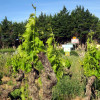
2019: WELL, AT LEAST WE HAD A HARVEST THIS YEAR
NOVEMBER/DECEMBER 2019
2018 at CHÂTEAUNEUF-DU-PAPE turned out to be a nightmare for three of its finest names, CHÂTEAU RAYAS, CHÂTEAU DE BEAUCASTEL and CLOS DES PAPES. Their harvests were ravaged by mildew, the problem exacerbated by working organically, and, in the case of BEAUCASTEL, unable to rustle up workers to get into the vineyards at night and at weekends, which was the only salvage option for the lesser sized family domaines. Tractors were also stuck if they tried to enter the waterlogged ground as the mildew moved relentlessly on to the bunches in just 24 hours in May.
At CHÂTEAU RAYAS, the birth of EMMANUEL REYNAUD’s first grandson, AUGUSTIN, the son of BENOÎT, was the reason to celebrate the year - the vineyard certainly wasn’t. “99% of the bunches were destroyed, the leaves also,” EMMANUEL recounted. “The leaves re-generated with grapillons or secondary bunches later on. On 28 November, 2018, in one day, we harvested 12 hl of RAYAS, 4 hl of CHÂTEAU DE FONSALETTE, and 5 hl of CHÂTEAUNEUF-DU-PAPE PIGNAN. There will be 400 litres of RAYAS BLANC and 800 litres of RAYAS ROUGE.” This will hopefully all be drunk en famille to toast AUGUSTIN as he grows up.
“I am quite content to have a year like that, since it shows the young generation why I keep wines back to sell,” affirms EMMANUEL philosophically. “It’s good if they can learn that early in their careers.”
In 2019, EMMANUEL was once again the last estate to harvest, bringing in his crop in the last days of October, and on 1 November. “It’s a large harvest,” he tells me, "a good budding, with very joli grapes aided by the mid-October rain, which served to re-balance the sugars, to render the fruit supple and less bitter than it was.”
Talking of 2018, CÉSAR PERRIN of BEAUCASTEL told this tale: “we lost 70%, and concentrated on the MOURVÈDRE, since the mildew hit the GRENACHE and then the SYRAH first. It is a high MOURVÈDRE vintage for the BEAUCASTEL ROUGES. Our yield was 7 hl/ha, the white crop a complete catastrophe. We are only selling our 2018 CHÂTEAUNEUF-DU-PAPE WHITES in FRANCE and GERMANY – you can’t sell six bottles here and there to different countries.”
At BEAUCASTEL, there is delight over the 2019 harvest, too. “The vineyard was very generous at 26-27 hl/ha this time round, which is high for us,” states CÉSAR. “The old vines didn’t feel the drought: the fact that they didn’t give harvest last year, coupled with their deep roots, saved us. We could take our time over the harvest, starting the first CÔTES DU RHÔNE whites on 27 August, and finishing with the last of the CHÂTEAUNEUF-DU-PAPE MOURVÈDRE on 10 October. Fermentations have been rapid, there’s enormous colour on the GRENACHE, degree isn’t much past 15° [that’s on the MOURVÈDRE], and the wines seem complete, balanced, elegant.”
VINCENT AVRIL has worked organically at CLOS DES PAPES for many years now, and suffered the consequences in 2018, with just 9 hl/ha. “The mildew attack at the end of May spread in 24 hours from a few spots on one leaf, just one leaf, into being all over the leaves and bunches. The last such year, I am told, was in the late 1940s. We took 18 days to harvest, to ensure that absolutely no dry matter entered the vats, and at least the quality of what we have is good. The wine has been pre-assembled this year, rather than being raised in six portions – there isn’t enough for six vats!”
In 2019, many fewer copper treatments were necessary, as the harvest was healthy, no sorting required, no maladies. “We are at 20 hl/ha this year,” states VINCENT. “Colour is very good, the tannins are jolis, and there’s good acidity. With only 72 mm [just under 3 in] of rain between 1 May and mid-September, when we started the red CHÂTEAUNEUF harvest, the profile of the year will be very distinct from 2018.”

